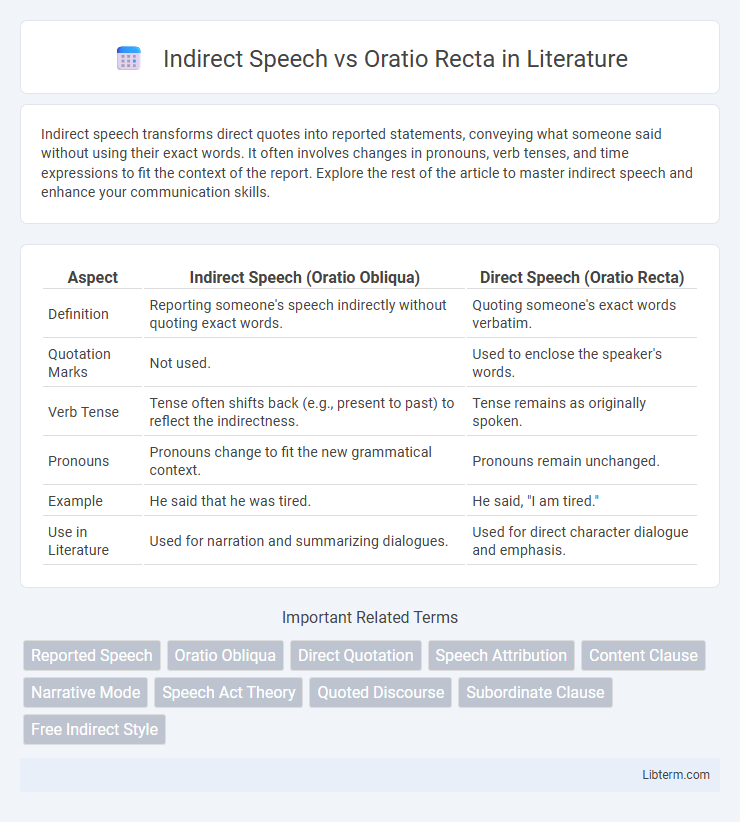Indirect speech transforms direct quotes into reported statements, conveying what someone said without using their exact words. It often involves changes in pronouns, verb tenses, and time expressions to fit the context of the report. Explore the rest of the article to master indirect speech and enhance your communication skills.
Table of Comparison
| Aspect | Indirect Speech (Oratio Obliqua) | Direct Speech (Oratio Recta) |
|---|---|---|
| Definition | Reporting someone's speech indirectly without quoting exact words. | Quoting someone's exact words verbatim. |
| Quotation Marks | Not used. | Used to enclose the speaker's words. |
| Verb Tense | Tense often shifts back (e.g., present to past) to reflect the indirectness. | Tense remains as originally spoken. |
| Pronouns | Pronouns change to fit the new grammatical context. | Pronouns remain unchanged. |
| Example | He said that he was tired. | He said, "I am tired." |
| Use in Literature | Used for narration and summarizing dialogues. | Used for direct character dialogue and emphasis. |
Introduction to Indirect Speech and Oratio Recta
Indirect speech transforms the exact words of a speaker into a reported statement, often involving changes in pronouns, verb tenses, and time expressions to fit the reporting context. Oratio recta, or direct speech, presents the speaker's original words verbatim, typically enclosed in quotation marks to indicate precise utterance. Understanding the distinction between indirect speech and oratio recta is crucial for accurate communication and grammatical correctness in language usage.
Defining Indirect Speech
Indirect speech, also known as reported speech, conveys someone else's words without quoting them directly, often transforming pronouns, verb tenses, and time expressions to fit the context. It differs from oratio recta, or direct speech, which reproduces the exact words spoken, enclosed in quotation marks. Indirect speech is essential for summarizing conversations and maintaining narrative flow, especially in written texts.
Understanding Oratio Recta (Direct Speech)
Oratio Recta, or direct speech, involves quoting the exact words spoken by a person, preserving the original tense, pronouns, and expressions. It maintains the speaker's tone and intent by placing the quotation within quotation marks, offering clarity and authenticity in communication. Understanding Oratio Recta is crucial for distinguishing it from indirect speech, which paraphrases or summarizes the original statement without exact wording.
Key Differences Between Indirect Speech and Oratio Recta
Indirect speech transforms direct quotes into reported statements by altering pronouns, verb tenses, and time expressions to fit the context, whereas oratio recta preserves the original speaker's exact words within quotation marks. The key difference lies in indirect speech's paraphrasing nature contrasted with oratio recta's verbatim reproduction of speech. Indirect speech often employs reporting verbs like "said" or "asked," while oratio recta presents dialogue or thoughts as they were originally expressed.
Grammatical Rules for Indirect Speech
Indirect speech involves reporting someone's words without quoting them directly, requiring verb tense shifts according to the sequence of tenses rule; for example, present simple changes to past simple, and present perfect changes to past perfect. Pronouns and time expressions must also be adjusted to fit the perspective of the reporting speaker, such as "I" becoming "he" or "she" and "now" changing to "then." Unlike oratio recta, which quotes the exact words, indirect speech demands syntactic transformations including the removal of quotation marks and the use of conjunctions like "that" to introduce the reported clause.
Grammatical Rules for Oratio Recta
Oratio recta involves quoting someone's exact words with the original tense, person, and word order preserved, requiring verb forms such as present, past, or future indicative based on the speech's timing. Quotation marks enclose the spoken words, and pronouns remain unchanged to reflect the speaker's perspective. The use of modal verbs, question forms, and exclamations must mirror the original utterance, maintaining accuracy and clarity in reporting speech.
Transformation Techniques: From Direct to Indirect Speech
Transformation techniques from direct to indirect speech involve changing the pronouns, verb tenses, and time expressions to align with the reporting context. In oratio recta, the exact words of the speaker are quoted within quotation marks, whereas indirect speech or oratio obliqua requires embedding the original statement within a reporting clause, often shifting present tense verbs to past tense. These adjustments ensure the reported message accurately reflects the original meaning while fitting the grammatical structure of the indirect narrative.
Common Mistakes in Indirect Speech and Oratio Recta
Common mistakes in indirect speech often include incorrect tense shifting, improper pronoun changes, and failure to adjust time expressions according to the reporting context. In oratio recta, errors frequently occur when punctuation and quotation marks are omitted or misused, leading to ambiguity in the original speaker's words. Understanding the syntactic and semantic rules governing both forms is essential to maintain clarity and accuracy in reported speech.
Usage Examples in Modern Communication
Indirect speech transforms direct statements into reported speech by adjusting tense, pronouns, and time expressions, commonly used in news reports and everyday conversations to convey someone's message without quoting verbatim. For example, instead of saying, "She said, 'I am tired,'" indirect speech converts it to "She said that she was tired," which is more natural in written and spoken communication. Oratio recta, or direct speech, retains the original phrasing and quotation marks, often employed in literary texts, interviews, and dialogues to capture the speaker's exact words and emotional tone.
Conclusion: Choosing the Right Form for Effective Expression
Selecting between indirect speech and oratio recta hinges on clarity and context; indirect speech effectively conveys reported information, while oratio recta provides direct dialogue impact. Understanding the nuances of verb tense shifts, pronoun changes, and mood alterations in indirect speech ensures accurate transmission of the speaker's original intent. Mastery of these forms enhances persuasive communication and precise expression in both written and spoken language.
Indirect Speech Infographic

 libterm.com
libterm.com